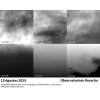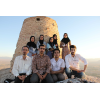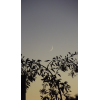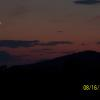Visibility of Dhul Qeadah Crescent 1436 AH
- When to Observe Dhul Qeadah Waxing (NEW) Crescent ?
- Dhul Qeadah Waxing (NEW) Crescent Observation Results
- The OFFICIAL First Day in Different Countries
- When to Observe Shawwal Waning (OLD) Crescent ?
- Shawwal Waning (OLD) Crescent Observation Results
When to Observe Dhul Qeadah Waxing (NEW) Crescent ?
The geocentric conjunction (Geocentric New Moon) will occur Inshalla on (Friday 14 August 2015) at 14:53 UT.
Sighting the new crescent on (Friday 14 August 2015) and (Saturday 15 August 2015) is shown in the below graphs using the program Accurate Times by Mohammad Odeh according to Odeh criterion. Where:-
- It is impossible to see the crescent from the areas located under the red color. Because either the Moon on this day sets before the Sunset and/or the topocentric conjunction occurs after the Sunset.
- The crescent is expected to be seen by optical aid only from the areas located under the blue color.
- The crescent is expected to be seen by optical aid from the areas located under the magenta color. In these areas the crescent could be seen by naked eye if the atmospheric conditions are superb and the observer is experienced.
- The crescent is expected to be easily visible by naked eye from the areas located under the green color.
- The crescent cannot be seen from uncolored areas, even though the Moon sets in these locations after the Sunset and the topocentric conjunction occurs before the Sunset, but the Moon is not sufficiently illuminated in order to be seen as crescent even by optical aid.
- Kindly notice that the below graph shows the possibility of seeing the crescent from areas between 60 degrees north of Equator down to 60 degrees south of Equator.


According to the Universal Hejric Calendar (UHC), which is based on the calculated crescent visibility, the start of this month in the Eastern Region will be on Sunday 16 August 2015 and in the Western Region will be on Sunday 16 August 2015. Kindly notice that the UHC is a pre-calculated calendar, which adopts a certain criterion to start the new Hejric month. Your country/organization might adopt different criterion to start the new Hejric month. So it is highly advised to read the UHC website before giving any judgment.
- Results of seeing the crescent, and the first day of the month in different countries will be added here Inshalla as we receive the reports from ICOP's members. If you wish to be a member in ICOP, or to know more about it, kindly click here.
Dhul Qeadah Waxing (NEW) Crescent Observation Results
Sat 15 August 2015
Australia
France
Germany
Eng. Martin Elsaesser said: "The day was correctly forecast as mostly cloudy with some rain. Only around noon were a few gaps to be hoped for. I had to wait for more than an hour with the imaging system tracking the correct spot in the sky for a gap to appear in the right spot. Th gap only lasted for a few minutes but that was enough to get some clear enough images, despite remaining haze. I used a very inexpensive lens with a larger field but that did not work to well under these difficult conditions. Still, i got some images."
Ghana
Mr. Abdul-Aziz Anyang said: "Today Saturday August 15 is the 29th day of Shawwal counting from the first night of Shawwal (July 17) when it was seen in almost region in Ghana. "
Mr. Baba Abdulai said: "Date of sighting effort; Saturday August 15, 2015. The crescent was NOT seen in this location. The sky was largely cloudy, per my observation; in fact almost completely cloudy. And Allaah (SWT) Knows Best. Sighting community; Sagnerigu, Tamale."
Indonesia
Mr. AR Sugeng Riyadi said: "I was tried to observe the new crescent of Thulkeadah 1436 AH with mr Darmawan Rasyid, Mr. Ibnu Zahid Abdo El-Moeid and also students of STAIN Ponorogo and members of BDK Surabaya at Condrodipo Gresik East Java, but the new crescent was not seen because the west horizon was partly cloudy. My students and mr. Ihsan Sani also tried to observe at Assalaam Observatory, but he moon was not seen. The new crescent of Thulkeadah 1436 AH was seen by ccd imaging at Bosscha Observatory, Lembang Bandung. The observer and photografer was Mr. Muhammad Yusuf."
Iran
Eng. Ali Janghorbani said: "Observer's: 1-Zahra Jamali 2-Zohreh Karimpoor 3-Zahra Fallahi 4-Nazanin Piroozmandan 5-Fatemeh Tavakoli 6-Masoomeh Haffar 7-Abdo reza Gholami 8-Shahriar Gholami 9-Mohammad Javad Nikeghbal 10-Alireza Mojiri 11- Ali janghorbani"
Mr. Hossein Janghorbani said: "In the name of God Thul Kea'dah Crescent Observation Report Astronomy and Geophysics Center of Shahreza – The Crescent Association of Shahreza Report by: Hossein Janghorbani (Najmosepehr-Sadrolmonajemin) – Manager of Shahreza Crescent Association and Red Crescent’s Astronomy and Geophysics Center Date: Saturday, 08/15/2015 Location: Damzad Mountaintop beside the historic Tower Senbandy in the East of Shahreza (latitude: 32 00 N, longitude: 51 52 E, elevation: 2325m from sea level, time zone: +4.5 GMT) Equipments: one sets of 15*70 , one sets of 20*90, one compass. Atmospheric condition: Hazy in western horizon. Horizon obstacles: 0/5° Apparent sunset: 19:46 Actual sunset: ---- Results: The Crescent moon is seen very dim at 20:01 by Hossein Janghorbani by binoculars 15*70 (which made by Celestron(sky master)) . This observation is done until 20:03 very difficult and after that the Crescent moon isnt seen Thul kea dah month 1426 year is difficulty. Observers: 1.Sayed Moslem Rezvani 2.Sayed Farzad Alavi 3.Reza Janghorbani 4. Hossein Janghorbani 5. Mahsa Khajeh 6. Zahra Farrokhpoor 7.Shakiba Moslehi 8. Naeemeh Sadat Saniee 9. Zohreh Khaksari "
Nigeria
Dr. Sani Mustapha said: "Summer season with cloudy horizons."
Oman
Prof. Mohammed Al-Bussaidi said: "The crescent was observed by using CCD image. It was very faint. The sky was slightly clouded."
Saudi Arabia
Sri Lanka
Mr. Abdul Rahman Razeen said: "A.alaikum.Today in some of the sighting places it was overcast and some places it was cloudy.Hence according to the astronomical predictions our country comes under optical aid.In regards to the negative sighting from the sighting places and to the astronomical predictions the C.G.M.H.C. which was presided by Moulana Riyadh (Baari) decided to complete the month of Shawwal 30 day's and the evening of the 16th Sunday will be the first of D.Qadah."
Tunisia
United States
Dr. Javad Torabinejad said: "I arrived at my sighting location (Blacksburg Middle School) at 8:26 pm EDT (sunset: 8:13 pm). Using a pair of binoculars (7X50), I started looking for the crescent in the clearings of a mostly cloudy and hazy western horizon with no success. At 8:36 pm, I sighted Mercury; I could not see it by naked eye, however."
Sun 16 August 2015
Ghana
Mr. Baba Abdulai said: "Date of sighting effort; Saturday August 16, 2015. The crescent was SEEN in this location. The sky was largely clear, per my observation. I expected to see a very big crescent quite easily; and rightly so. Sighting community; Sagnerigu, Tamale."
Morocco
Saudi Arabia
United States
Dr. Javad Torabinejad said: "On the way to my sighting location, I sighted the crescent with naked eye at 8:33 pm EDT (sunset: 8:12 pm). The horns were at 1:30 and 6:00 O'clock (1:30;4:00;6:00). Using a pair of binoculars (7X50), I sighted Mercury at 8:42 pm and till it set behind a distant mountain at 8:56 pm, I was unable to see it with naked eye. I stayed at my sighting location till the upper horn of the moon disappeared behind the mountain at 9:03 pm (moonset: 9:13 pm)."
The OFFICIAL First Day in Different Countries
Sun 16 August 2015
1 . Indonesia
2 . Iran
3 . Oman
4 . Sri Lanka
Mon 17 August 2015
1 . Australia
2 . Morocco
When to Observe Shawwal Waning (OLD) Crescent ?
The geocentric conjunction (Geocentric New Moon) will occur Inshalla on (Friday 14 August 2015) at 14:53 UT.
Sighting the OLD crescent on (Friday 14 August 2015) and (Thursday 13 August 2015) is shown in the below graphs using the program Accurate Times by Mohammad Odeh according to Odeh criterion. Where:-
- It is impossible to see the OLD crescent from the areas located under the red color. Because either the Moon on this day rises after the Sunrise and/or the topocentric conjunction occurs before the Sunrise.
- The crescent is expected to be seen by optical aid only from the areas located under the blue color.
- The crescent is expected to be seen by optical aid from the areas located under the magenta color. In these areas the crescent could be seen by naked eye if the atmospheric conditions are superb and the observer is experienced.
- The crescent is expected to be easily visible by naked eye from the areas located under the green color.
- The crescent cannot be seen from uncolored areas, even though the Moon rises in these locations before the Sunrise and the topocentric conjunction occurs after the Sunrise, but the Moon is not sufficiently illuminated in order to be seen as crescent even by optical aid.
- Kindly notice that the below graph shows the possibility of seeing the crescent from areas between 60 degrees north of Equator down to 60 degrees south of Equator.


Shawwal Waning (OLD) Crescent Observation Results
Thu 13 August 2015
Germany
Eng. Martin Elsaesser said: "Skies were hazy in the east before sunset. I rode my bike for a few kilometers to find a clear spot. I could easily enough see the crescent with small binoculars but found it quite hard to see with the naked eye. As the binoculars showed them clearly i knew exactly were to look and that helped a lot. No chance to it with a simple just-look-to-the-east approach. I took some images with a cheap 400mm lens. One is raw, one has strong contrast stretching."
Indonesia
Mr. AR Sugeng Riyadi said: "On Thursday, 13 August 2015 the old crescent of Shawwal 1436 AH was easy seen from Assalaam Observatory, The Modern Boarding School of Islam ASSALAAM, Pabelan Kartasura Sukoharjo Surakarta Central Java Indonesia."





















